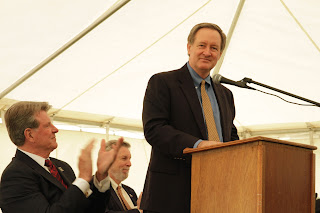What I did well:
I believe I did a fairly good job of capturing the event from a documentary perspective
I tried very hard to think in layers and incorporate details that add to the story in the fore- and background. Although in hind sight I could have done better, I think I did better than I have in previous attempts.
There are quite a few good examples of Action, Mood, Emotion and Moment as well as Perspective but Perspective is still a weak point. The security people asked the media people not to enter into the section of the tent where the podium was. Thus it was had to get very close requiring longer focal lengths for closeup shots.
Overall, I took far fewer photos than I would have in the past. My ratio of good to bad photos has improved significantly. I really had a hard time editing down the number of keepers because so many photos turned out far better than I expected.
What I did not do well:
Changing light and overall poor lighting conditions, especially under the tent. I had a significantly higher number of bad exposures than I did before when the weather conditions were more favorable.
Perspective is still an area that needs improvement. I tried to take photos from low angles, looking up at my subject but was limited by close access to the podium. As it was, I finished the job wet and covered in mud so I did not do too badly. I just have to keep working on it. There was no way to get up above the crowd to shoot down without leaving the area and using a telephoto lens. I decided not to do this because it would have taken me away from the action where things where taking place pretty quickly. It would also have produced limited payoff because the tent would have blocked much of the activity.
For most of the shoot I used my 28-75mm lens. There were times I could have used my 70-200mm to get better closeup shots. There were two considerations which kept me from doing this. The first is that I could have used two cameras, one with each lens. But my secondary camera would have required ISO settings in the unacceptable range for photo quality. My Canon 40D does not make good photos at much above ISO1000 or 1250. ISO1600 just looks ugly and I was using ISO2000-2500 on my 7D. The second reason I did not end up switching lenses is that I was totally under equipped to deal with all the mud. I was covered in mud and soaked from the rain and switching lenses did not seem like a good idea. I decided to do the best I could with the 28-75mm lens and call it good.
Being wet and cold, I had to use significantly higher ISO setting to keep my shutter speed very high because I was shivering so much it was interfering with my photos, causing too much blur.
What I had trouble with and need to learn more about:
Lighting was a big problem again. I did have high enough ISO setting on my 7D to get things to work out but I had quite a few photos that were over and under exposed. The light conditions were constantly changing and the activity was constant making it hard for me to adjust quickly enough at times. This will need practice.
I need to learn more about the metering settings on my camera. I have been using evaluative metering. Perhaps there is a better mode to use under the lighting conditions I was in. The manual suggests that partial metering might be better when the background is brighter than the subject.
The stats:
522 Photos total (many shots were retaken due to poor exposure)
356 Photos remained after bad photos were removed
47 Really nice photos (although I started having difficulty editing the list down at around 100 photos because there were many good ones also)
Click on photo to enlarge















































Pay attention to those settings. You had mentioned that it was dark underneath that tent and you had to shoot at a high ISO. But a few of those frames you were shooting at f7.1. If it's dark, you should have that aperture opened all the way up.
ReplyDeleteAnd watch that focus too. The shots of Crapo and Butch holding the artwork is focused on the artwork rather than them. Focus on those eyes unless you want to focus on the art. If that's the case, you need to recompose the frame to let the viewer know the most important aspect of the frame is the pottery.
Your best frame in this edit is the last shot of the American Legion member. It's a nice, clean portrait, but you have that little bit of hair in the left of the frame. Work that frame and make sure you only have what you want in there.
I think you are using lens selection in the most general terms. Don't think in terms of wide and close-up, but rather what you can do to tell a little bit more with you lens selection. Use that telephoto to compress a scene and build in layers. Bust out the "wide" to build in more elements into the frame or to include more information.
We'll go over these shots again during our sit down this week.